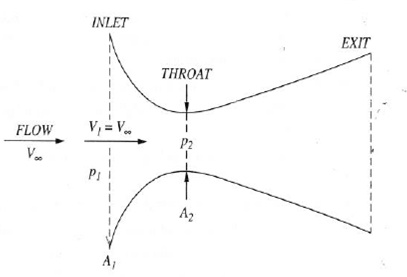
Introduction to Flight 7th Edition by John Anderson
Edition 7ISBN: 978-0073380247
Introduction to Flight 7th Edition by John Anderson
Edition 7ISBN: 978-0073380247 Exercise 4
An instrument used to measure the airspeed on many early low-speed airplanes, principally during 1919 to 1930, was the venturi tube. This simple device is a convergent-divergent duct. (The front section's cross-sectional area A decreases in the flow direction, and the back section's cross-sectional area increases in the flow direction. Somewhere between the inlet and exit of the duct, there is a minimum area called the throat.) See figure below. Let A 1 and A 2 denote the inlet and throat areas, respectively. Let p 1 and p 2 be the pressures at the inlet and throat, respectively. The venturi tube is mounted at a specific location on the airplane (generally on the wing or near the front of the fuselage) where the inlet velocity V 1 is essentially the same as the free-stream velocity-that is, the velocity of the airplane through the air. With a knowledge of the area ratio A 2 /A 1 (a fixed design feature) and a measurement of the pressure difference p 1 - p 2 , we can determine the airplane's velocity. For example, assume
 . If the airplane is flying at standard sea level, what is its velocity?
. If the airplane is flying at standard sea level, what is its velocity?

 . If the airplane is flying at standard sea level, what is its velocity?
. If the airplane is flying at standard sea level, what is its velocity?
Explanation
4.4 From Bernoulli's equation,
Also f...
Introduction to Flight 7th Edition by John Anderson
Why don’t you like this exercise?
Other Minimum 8 character and maximum 255 character
Character 255



